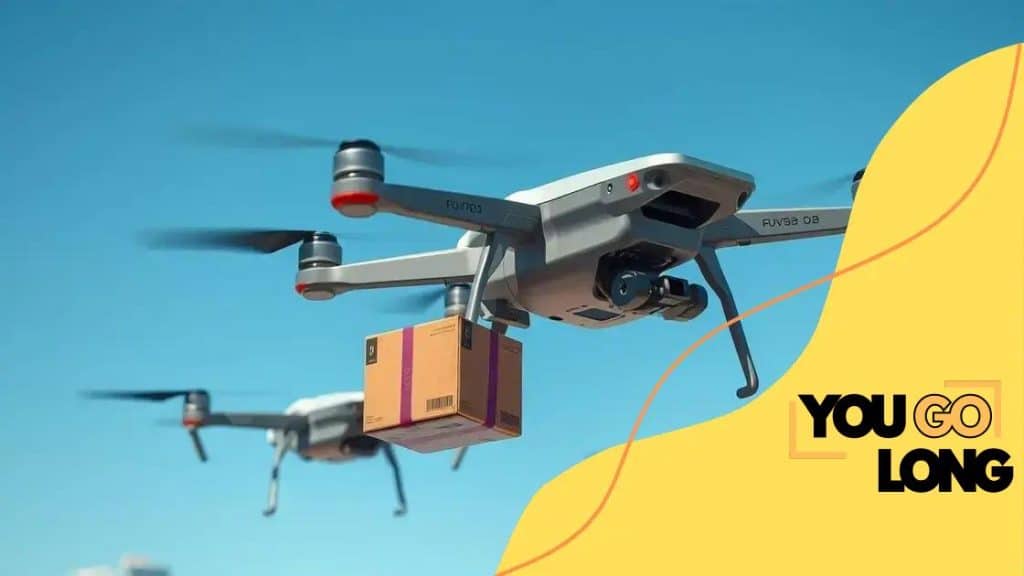The role of drones in modernizing delivery services

Advertisement
The role of drones in modernizing delivery services includes speeding up deliveries, reducing costs, and reaching remote areas, while facing challenges like regulatory restrictions and safety concerns.
The role of drones in modernizing delivery services is becoming increasingly vital. Have you ever wondered how these flying machines could change the way you receive packages? Let’s explore the potential.
How drones enhance delivery speed
In today’s fast-paced world, drones play a crucial role in enhancing delivery speed. By utilizing advanced technology, these innovative machines can navigate city landscapes quickly and efficiently.
This rapid delivery capability is transforming the way businesses operate. Companies are increasingly adopting drone technology to meet customer demands for faster service.
Advertisement
How Drones Improve Delivery Efficiency
Drones offer several advantages that enhance delivery performance. Their ability to bypass traffic and take direct flight paths ensures that packages reach consumers without delay.
- Instant delivery to remote locations
- Reduced delivery times during peak hours
- Lower environmental impact compared to trucks
This innovative approach not only speeds up delivery but also reduces costs. Some studies suggest that using drones for last-mile delivery can cut expenses significantly. Moreover, companies can allocate resources more effectively when they rely on drone technology.
Real-World Examples
Several companies have already embraced the potential of drones. For instance, major retailers are experimenting with drone deliveries to reach customers more efficiently. The results so far are promising, with reduced wait times and positive customer feedback.
Advertisement
By incorporating drones, businesses can enhance their logistics infrastructure. This shift not only meets consumer expectations but also sets a new standard in the industry.
As more organizations embrace this trend, the future of delivery looks brighter. The efficiency of drones will continue to provide a competitive edge, reshaping the landscape of package delivery forever.
Benefits of using drones in delivery
The use of drones in delivery services brings numerous advantages. One of the most significant benefits is the speed at which packages can be delivered. With the ability to fly directly to their destination, drones can cover distances much faster than traditional delivery vehicles.
Additionally, drones can operate in areas that might be difficult for trucks to access. This capability allows businesses to reach customers in remote locations where conventional delivery methods may fall short.
Key Advantages of Drone Delivery
- Cost-effective operations due to reduced fuel and labor costs
- Environmentally friendly, as they produce fewer emissions
- Increased reliability, leading to higher customer satisfaction
Moreover, using drones minimizes traffic congestion. They can bypass road conditions that usually delay deliveries, especially in urban environments. This means packages can be delivered even during peak hours without significant delays.
Another crucial benefit is the potential for 24/7 delivery. Drones can operate beyond traditional business hours, providing flexibility that modern consumers expect. This availability enhances customer service, allowing for faster response times.
Impact on Businesses
For businesses, incorporating drones into their logistics can lead to significant operational improvements. Reducing the time and cost of deliveries can enhance profit margins and allow businesses to offer competitive pricing.
As more companies adopt drone technology, the industry as a whole may see a shift toward faster and more reliable service options. The advantages listed above show that drones are not just a trend; they represent the future of delivery.
Challenges faced by drone delivery systems

While drones present exciting opportunities for delivery services, there are significant challenges that must be addressed. One major issue is regulatory constraints. Various governments have strict rules regarding where and how drones can operate. These regulations can slow down the integration of drone technology into existing delivery frameworks.
Another challenge is the technological limitations of drones themselves. Factors such as battery life and payload capacity can restrict their effectiveness. Most drones can only carry lightweight packages and have limited flight times, which impacts their practical applications.
Safety and Privacy Concerns
Safety is a paramount issue when it comes to drone delivery. Drones must navigate complex airspace, often populated by other aircraft. Ensuring that these deliveries are conducted safely is crucial to avoid accidents.
- Potential for mid-air collisions
- Risks of crashes in populated areas
- Noise pollution affecting communities
Privacy concerns also arise with drones. Many people are wary of being monitored or having their personal information compromised during delivery processes. This feeling can hinder public acceptance of drone technology.
Infrastructure and Cost Issues
Developing the necessary infrastructure to support drones is another hurdle. This may involve creating designated landing zones and charging stations. The costs associated with building this infrastructure can be prohibitive for smaller businesses.
Furthermore, the initial investment for drones and related technology can be high. Smaller companies may struggle to compete as they attempt to implement these systems effectively. As the market evolves, overcoming these challenges will be crucial for the successful adoption of drone delivery.
Future trends in drone delivery services
The future trends in drone delivery services are shaping up to be quite exciting. As technology continues to advance, we can expect to see drones becoming more integral to logistics and delivery systems. Enhanced battery life and improved navigation systems will allow drones to operate more efficiently and over longer distances.
Additionally, the use of artificial intelligence in managing drone fleets is expected to increase. AI can help optimize delivery routes, reduce delivery times, and minimize human error. As these technologies develop, businesses will be able to offer faster and more reliable services to consumers.
Next-Generation Drone Features
Future drones are likely to come equipped with advanced features. These may include:
- Obstacle detection, ensuring safer navigation through complex environments
- Collision avoidance systems to improve safety
- Increased payload capacity for transporting larger packages
By integrating these features, drone delivery can become safer and more capable. This would enable the delivery of a wider variety of products, expanding their use beyond just small packages.
Integration with Smart Cities
As cities become smarter, the integration of drone delivery with urban infrastructure will be key. Future developments may include designated drone lanes and landing zones in busy urban areas. This planning will facilitate seamless deliveries while reducing congestion.
Moreover, partnerships between companies and local governments can lead to the establishment of regulations that promote the safe use of drones. As regulatory frameworks evolve, they will support innovation while ensuring public safety and privacy.
In conclusion, the direction of drone delivery services points toward enhanced efficiency and reliability. The combination of technological advancements and smart urban planning will further transform how we think about logistics and delivery.
Real-world examples of drone delivery innovations
Real-world examples of drone delivery innovations show how businesses are transforming their services. Companies around the globe are implementing drones to enhance their logistics. For instance, medical supply deliveries are becoming more efficient in remote areas, where traditional transport can be slow.
One notable success story is Zipline, a company that uses drones to deliver blood and vaccines to hard-to-reach regions. By flying over difficult terrains, Zipline has considerably reduced delivery times, saving lives in emergencies. Their operational model demonstrates the profound impact drones can have on healthcare.
Other Notable Innovations
Several other companies are also pushing the boundaries of drone delivery. For example:
- Amazon is testing its Prime Air service, which promises to deliver packages in 30 minutes or less using drones.
- UPS has partnered with Matternet to use drones for medical deliveries in urban areas, proving their feasibility.
- Domino’s Pizza has successfully trialed drone delivery in certain locations, showcasing how restaurants can speed up food delivery.
These examples highlight that the potential for drone delivery is vast and varied. Companies are not only focusing on speed but also on reducing costs and environmental impact. As more businesses explore drones, we can expect a revolutionary shift in how products are delivered.
In addition, technologic partnerships are forming to address issues like safety and regulation. Companies are collaborating with government agencies to create frameworks that allow safe drone operations. This cooperation is essential for paving the way for widespread adoption of drone technology in delivery services.
FAQ – Frequently Asked Questions about Drone Delivery Services
How do drones improve delivery speed?
Drones have the ability to fly directly to their destination, bypassing traffic and reducing delivery times significantly compared to traditional vehicles.
What are the main benefits of using drones for delivery?
Key benefits include cost efficiency, access to remote areas, faster service, and reduced environmental impact.
What challenges do drone delivery systems face?
Challenges include regulatory restrictions, safety concerns, technological limitations, and the high costs of infrastructure development.
What are some real-world examples of successful drone delivery?
Companies like Zipline deliver medical supplies in remote areas, while Amazon and UPS are testing urban package deliveries using drones.





